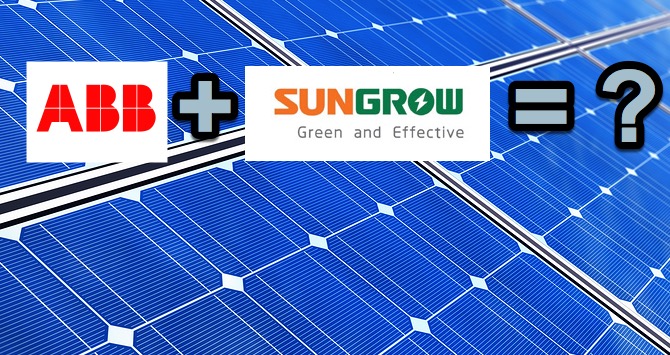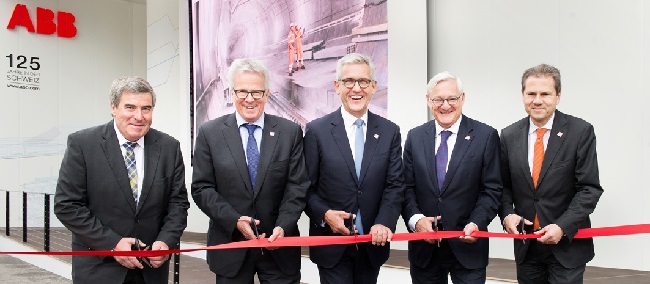
Sungrow and ABB announce a ‘strategic alliance’ to make big inverters.
Sungrow, China’s largest manufacturer of inverters, and ABB, a Swiss based company that is one of the largest engineering conglomerates in the world, have joined forces to create a strategic alliance which is expected to benefit both companies far more than a non-strategic alliance would.
On the 2nd of June they signed an agreement to work together to design a megawatt class 1,500 volt, central inverter system using Sungrow’s inverters and ABB’s transformers.
They have pinky promised to also promote each others’ products and improve cooperation between the two companies for a period of three years.
Who The Hell Is Sungrow?
Sungrow is China’s, and the world’s, second largest producer of solar inverters. In terms of capacity, Sungrow inverter production is second only to that of China’s Hauwei Technologies company. However, in terms of the number of dollars worth of sales, Germany based SMA beat them both, despite shipping less capacity in total.
Sungrow was founded in 1997 and is headquartered in the the inland Chinese city of Hefei. And if there is anywhere in the world that would benefit from more solar power, it is Hefei. In May and June the air there is like breathing the contents of filthy deep fry that hasn’t had its oil changed for 50 years.
Sungrow employs around 1,500 people. It has been listed on the Shanghai stock exchange for 5 years and in that time it has managed a growth of around 20% a year, while the average company managed 1%. But note that past performance is no indicator that you will be able to make a mint from their shares in the future. Their market capitalization, which is how much all their shares are worth together, is around $3 billion.
Who The Hell Is ABB?
ABB is one of the world’s largest engineering conglomerates and was formed from the merger of the Swedish company ASEA and the Swiss company Brown Boveri in 1988. ABB then went on to win the Euroengineering Song Contest in 1989 and had a resurgence in popularity with the success of the musical Mamm Mia!
ABB operates in around 100 countries and has around 135,000 employees1, with around 1,600 of them in Australia, many of whom are involved in writing software for mining and other applications.

Despite some labour inefficiency (it shouldn’t take more than three people to cut that ribbon), ABB is looking to expand in Australia.
The corporation’s main business is automation and robotics with around 40% of its workforce involved in this area. The company is also heavily involved in the production of equipment for electricity grids, including central inverters for commercial and utility scale solar power, and this employs about 28% of their workers.
Over the past 10 years ABB’s share price has risen by an annual average of 3.1%. And that is pretty good considering that most of the world’s developed countries decided to have a not so great depression in that time. Its market capitalization is around $59 billion.
Just What Are Sungrow And ABB Doing Together?
What are Sungrow and ABB up to together? Well, they are making a baby. Specifically they are working together to design a containerised, megawatt scale 1,500 volt central inverter for utility scale or large scale commercial solar installations. While there are already both Sunpower inverters and ABB inverters that are 1,500 volts, presumably they believe that by combining their company DNA they can create something even better. And anything that has the potential to bring down the cost of solar power good thing as far as I am concerned, so I hope this project goes well for them.
They have agreed to cooperate for three years and in addition to working together on a new inverter they have promised to promote each others’ products. Also, they have said they will cooperate on “core products”, “technical innovation”, and “services”. And if all that that sounds a bit vague to you, don’t worry, it also sounds vague to me and exactly like the sort of thing that always seems to get repeated whenever two companies put ink to an agreement.
While developing a new type of central inverter may not seem all that exciting, if their alliance is successful it could lead to further, hopefully productive, cooperation in the future.
Footnotes
- Update 25 February 2024: Note that ABB has had some job losses since this article was written and is now down to around 110,000 employees. ↩

 RSS - Posts
RSS - Posts



Ronald, in the second paragraph, should “1,500 watt” perhaps be “1,500 volt”?
(Unless it’s “1,500 kilowatt”)
It might be a good unit for a microgrid shared with the nearest neighbour, a bit over a kilometer away on top of the next hill. Six times 240v = 1/36th of the transmission losses. Farmers are independent souls, though, and that microgridding lark has to be a lot dearer than just banging in a bigger array and letting the energy distribute itself in the sky. (And you don’t have to be a dairyfarmer to be heavy on capital investment but deficient in income.)
yep – should be 1,500V – fixes up now – thanks.
Thanks for the catch, Erik.
My understanding is that in South Australia for 3 phase solar PV and three phase network supply, normally only one phase is metered for time of use, it seems there may be two meters one three phase, with one of those phases having a separate time of use capable meter.